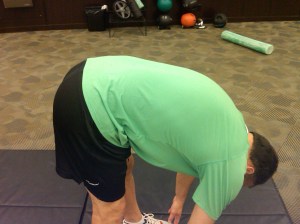My Top Low Back Fixes
Today I thought I’d give everyone out there a Top 5 style list of some of the main concerns I find when I’m dealing with people who have low back pain. Most of the time, these problems are pretty simple to fix if you have a game plan going into it based on some simple assessments, and an outline of what they are doing well and what they aren’t doing well with respect to movements. strength, mobility, and posture. Occasionally it’s saying “Stop doing that stupid shit from the Jillian Michaels DVD,” or “drink more water,” but most cases tend to take something else.
Fix #1: Smartening Up Dumb Movements
Most low back pain is the result of a combination of poor posture (high amplitude low velocity movements that result in chronic stress and tissue breakdown) and movement patterns that compensate for weakness in other body parts. Movement will always occur, whether we move from the hips, spine, shoulders, or whatever else we want to use, the movement will always happen. Sort of like no matter how much you try to ignore them, Jersey Shore just keeps happening!!! If the hips aren’t doing their job, the back has to pick up the slack, which it may not be strong enough to handle. When the load exceeds the tolerance of the tissue, injury happens. Most improper movements that directly impact the low back are as follows:
Lack of hip flexion ROM
Lack of hip internal rotation ROM
Lack of hip extension strength
Lack of external rotation strength
Lack of thoracic spine extension and rotation ROM
Lack of abdominal and low back strength
Lack of scapular retraction and depression ROM
Lack of glenohumeral external rotation
Simply put, there’s very few back injuries that come from an excess of strength in any area, with the exception of those who are elite powerlifters or bodybuilders, which means most problems come from a lack of strength or mobility. The only exceptions to this statement are the elite powerlifters and gymnasts/dancers who have huge compressive forces and ridiculously unstable spines, respectively.
Sahrmann showed that movement impairment syndromes can be broken down into intolerances to movements in flexion, extension, flexion/rotation, and extension/rotation. Once the offending movement pattern is identified we can look at the corrective strategy based on the movement, rather than chasing the specific tissue, muscle, nerve, etc that may be causing the problem, and looks at the gross movement patterns that encompass them all at the same time. McGill even stated that a lot of their assessments look at what movements cause pain, what movements don’t, and working on increasing the movement ability in a pain-free context.
Here are a few of the assessments I use to test the mobility patterns of the spine, and the main things I’m looking for are which movements are smooth and fluid through a full ROM, whether they cause pain, and if so where the pain is coming from.
The techno music in the background is an added bonus for you. Enjoy it.
I could go crazy on this one and write a few dozen pages on it alone, but I’ll save your eyes a little degeneration from staring at the computer screen and move on.
Fix #2: Stable isn’t just a quality you want in a date
There’s very few people who can get by while being unstable: Dennis Quaid, Kanye West, Naomi Campbell, Megan Fox, and very few after that.
Your spine isn’t something that should be on this list. Instability means that one or more vertebrae won’t be moving properly, which means that another vertebrae will move too much (hence the instability). This excessive vertebral movement stresses the associated tissues (muscles, ligaments, nerves and fascia, baby!!!), which can lead to back pain. Check out this example of a client who came in with an obvious spinal hinge at L2-3, and after 10 minutes the hinge had reduced dramatically.
When a vertebrae slips, the tissues that have to hold it together get stressed out and wind up either breaking down or shutting off, kind of like me when Lindsay starts nagging me quite correctly pointing out that I need to do the dishes.
Spinal stabilization means making the muscles of the abdomen and low back contract to decrease some of that slipperiness of the loose vertebrae. To do this, the spine has to be in a neutral posture and the goal is to make sure the spine maintains posture while forces are applied to the body that try to move it out of a neutral posture. These types of forces are either trying to cause rotation, flexion or extension, therefore the movements are known as anti- rotation and anti- flexion/extension exercises. Cool isn’t it?? Hells yeah. Here’s an introductory spinal stability circuit I have a lot of new back pain clients go through to get their muscles working properly again without straining the tissues of the spine.
The exercises aren’t in a particular order, but would typically go from fully supported (on the roller) to partially supported (plank variations) to unsupported and externally loaded (cable work).
Unfortunately, even with a circuit like this, Dennis Quaid is still a nutbar looking to seek asylum in Canada from celebrity whackers. HyOOOOOOOge instability there, boy!!
Fix #3: Dumbass ain’t just a saying of Red Foreman
As mentioned earlier, movement will happen whether one area is strong enough to make it happen or not, which tends to result in imbalances and compensations. 99 times out of 100, back pain couples with a weak ass. On top of that, it’s also dumb and doesn’t know what to do when it’s called on.
The glutes conjoin within the lower back through the thoracolumbar fascia, and also integrate with the contralateral shoulder, meaning ya gots ta move yo ass, man!!
Let’s say your glutes are an anchor that ties down the thoracolumbar fascia. If the glutes are weak or lack the capacity to turn on properly, they aren’t going to be able to pull the fascia tight and help resist excessive mobility of the spine. This is like pulling a sail on a boat and leaving the rope slack. Bad stuff’s gonna happen.
Getting the glutes to fire is one of the keys to helping to fix a bad back. Bret Contreras is huge on glute training, and I’ve taken a few of his keys, including the heavy bench hip press (Tim Ferriss version or other, I don’t really care, just do it).
I’m sure I just made every lady out there a little bit redder, and probably made a bunch of guys jealous. What?? Everyone loves a good hip press. They’re all envious of my glute strength.
Another fantastic ass-ripper that I always love doing is the 1-arm 1-foot squat & row so as to get maximal activation out of the thoraco lumbar anchors (glutes and lats)
Nothing to be envious about here. Just my fantastic balance.
Fix #4: Train the Abs, even with Crunches
Yes, I know, crunches are the devil and will make you paralyzed from the groin down if you ever even attempt one. Bull. The only time I’ll be avoiding crunches is with a client who has had a recent (and I mean within the past week) discogenic injury. Other than that, I’ll be making them do crunches, PROPERLY. Check out my previous post on how spinal flexion won’t actually kill you, it’s been pretty popular, and I have to say it’s probably the best piece you will ever read about anything, ever.Also, they will be doing a lot of abdominal work, trying to make the abs work through all three dimensions (flexion/extension, lateral flexion, and rotation). This will help to make all the core muscles work to help support the spine through the corset mechanism.
Fix #5: Teach Abdominal Bracing
Jillian Michaels is an idiot. Just thought I’d throw that out there. If you don’t believe me, here’s the proof.
I don’t know what the hell she is trying to do, but I want to punch a kitten in the face when I watch this.
What she fails to tell anyone is how to actually make their abs work to protect their spine. McGill showed that performing abdominal bracing, where you flex the entire abdomen, is the best way to stabilize the spine and prevent problems with the back, and is far superior to drawing in the belly button or any other type of ab activation. In every movement a back pain client does, they start with a braced abdomen so that there is little chance of vertebral slipping or anything like that. Additionally, the benefit of co-contraction from muscles associated with the abs helps to increase stability throughout the body and in pretty much every lift you could do. Don’t believe me? Next time you go to deadlift, try to do it with flabby abs, then do it again with a rock solidly flexed tum-tum. I guarantee the second option will have you lift more, and the first option will have you rip your rectum and herniate a nut. Maybe that’s what Jillian should do.
I know I go off against her a fair bit, but come on!!! I guess I need to take a few of these:
So there you have it, my Fast Five for Fixing Failed Facets:
Smarten up Dumb Movements
Stability
Find some Ass Power
Train the Abs
Teach Abdominal Bracing
Easy stuff, right? I’ve been able to help hundreds of people with chronic, low-grade, acute, post-surgical, biomechanical dysfunction, and atrophy to all live with less back pain and even end it altogether using these Five main points. Hopefully they help you out as well as any clients you may have.





6 Responses to My Top Low Back Fixes